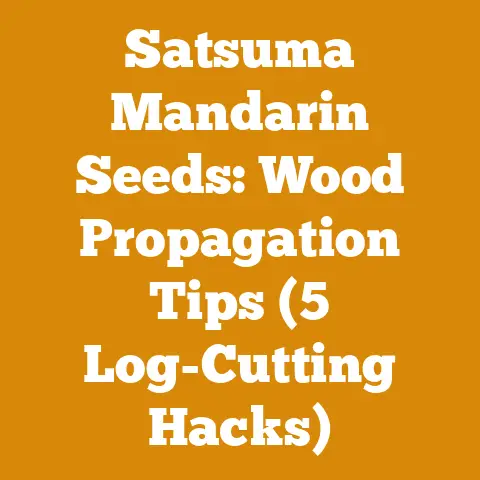Timber Frame Garage Cost (5 Joinery Tips Pros Swear By)
Let’s talk about timber frame garages. What makes them so appealing, besides the obvious beauty? It’s the low maintenance. Seriously! Once that frame is up and properly protected, you’re looking at decades of minimal upkeep. No constant painting like a stick-built structure, no worries about hidden rot in stud walls. Just solid, exposed timber doing its thing, year after year.
That’s why I’m so passionate about timber framing. It’s a return to craftsmanship, to building things that last. And while the initial investment in a timber frame garage might seem higher, the long-term benefits, especially in terms of reduced maintenance and sheer durability, often outweigh the costs. Plus, let’s be honest, they look fantastic!
Timber Frame Garage Cost: A Deep Dive
Building a timber frame garage is a significant investment, so understanding the cost breakdown is crucial. Several factors influence the final price, and I’m going to walk you through each one.
1. Design and Size
The size of your garage is the most obvious cost driver. A simple one-car garage will naturally be cheaper than a sprawling three-car structure with a workshop attached. The complexity of the design also plays a role. A basic rectangular frame is less expensive than a design with curved braces, intricate joinery, or multiple roof pitches.
- Simple One-Car Garage (12′ x 20′): Expect to pay between \$15,000 and \$30,000 for the timber frame alone.
- Two-Car Garage (24′ x 24′): The timber frame cost can range from \$25,000 to \$50,000.
- Three-Car Garage with Workshop (30′ x 40′): This can easily exceed \$50,000, potentially reaching \$80,000 or more.
These are just estimates, of course. The actual cost will depend on the specifics of your project.
2. Wood Species
The type of wood you choose for your timber frame significantly impacts the price. Different species offer varying levels of durability, strength, and aesthetic appeal.
- Eastern White Pine: This is often the most affordable option. It’s easy to work with, but less resistant to rot and insects than other species. Expect to pay around \$3 to \$5 per board foot.
- Douglas Fir: A popular choice for its strength, straight grain, and relative affordability. It’s more durable than pine and offers a beautiful look. The cost typically ranges from \$5 to \$8 per board foot.
- White Oak: Known for its exceptional strength and resistance to decay, white oak is a premium choice. It’s more difficult to work with but offers unparalleled longevity. Expect to pay \$8 to \$12 or more per board foot.
- Western Red Cedar: Prized for its natural resistance to decay and insects, as well as its beautiful reddish-brown color. It’s a softer wood, making it easier to work with. The cost is typically around \$7 to \$10 per board foot.
Personal Anecdote: I once worked on a project where the client insisted on using reclaimed barn beams for their garage frame. While it looked incredible, sourcing those beams was a nightmare! Not only were they incredibly expensive, but ensuring they were structurally sound and free from pests was a major challenge. We ended up rejecting about half of the beams due to rot or insect damage. Sometimes, new wood is the better option, even if it lacks the “character” of reclaimed timber.
3. Joinery Method
The complexity of the joinery will also influence the cost. Simple mortise and tenon joints are less expensive than more elaborate dovetail or scarf joints. Hand-cut joinery is generally more expensive than machine-cut joinery, but it offers a higher level of craftsmanship and precision.
- Mortise and Tenon (Machine-Cut): This is the most common and cost-effective joinery method. It involves creating a rectangular hole (mortise) in one timber and a corresponding projection (tenon) on another. The two pieces are then joined together and secured with a wooden peg.
- Mortise and Tenon (Hand-Cut): This method requires more skill and time, but it results in a tighter, more precise fit. Hand-cut joints also have a certain aesthetic appeal that machine-cut joints lack.
- Dovetail Joints: These joints are known for their exceptional strength and resistance to pulling forces. They are often used in areas where the frame is subjected to high stress.
- Scarf Joints: These joints are used to connect two timbers end-to-end, creating a longer timber. They are often used in beams or rafters.
Data Point: A study by the Timber Framers Guild found that hand-cut joinery can increase the cost of a timber frame by 20-30% compared to machine-cut joinery. However, the study also found that hand-cut frames tend to last longer and require less maintenance over time.
4. Labor Costs
Labor costs can vary significantly depending on your location and the experience of the timber framers you hire. Hiring a reputable and experienced crew is essential to ensure that your frame is built correctly and safely.
- General Contractor: If you’re hiring a general contractor to oversee the entire project, they will typically charge a percentage of the total cost (usually between 10% and 20%).
- Timber Frame Specialist: Hiring a timber frame specialist to design and build the frame will likely be more expensive than using a general contractor, but it can be worth it if you want a high-quality frame.
- Hourly Rate: Timber framers typically charge an hourly rate, which can range from \$50 to \$100 or more per hour.
Insight: Don’t be afraid to get multiple quotes from different timber framers. Ask for references and check their previous work. A little research can save you a lot of money and headaches in the long run.
5. Raising the Frame
Raising a timber frame is a complex and potentially dangerous process. It requires specialized equipment and experienced personnel. You can either hire a professional raising crew or attempt to raise the frame yourself with the help of friends and family.
- Professional Raising Crew: Hiring a professional crew is the safest and most efficient option. They have the equipment and expertise to raise the frame quickly and safely. The cost can range from \$5,000 to \$15,000 or more, depending on the size and complexity of the frame.
- DIY Raising: If you’re experienced with timber framing and have access to the necessary equipment (cranes, forklifts, etc.), you may be able to raise the frame yourself. However, this is not recommended for beginners.
Safety Standard: Always consult with a structural engineer before attempting to raise a timber frame. They can help you develop a safe and effective raising plan.
6. Enclosure and Finishing
Once the frame is raised, you’ll need to enclose it with walls and a roof. The cost of the enclosure will depend on the materials you choose.
- Siding: Options include wood siding, vinyl siding, metal siding, and brick.
- Roofing: Options include asphalt shingles, metal roofing, wood shingles, and slate.
- Windows and Doors: The cost of windows and doors will depend on the size, style, and quality.
Cost-Effectiveness: Consider using locally sourced materials for the enclosure. This can save you money on transportation costs and support your local economy.
7. Foundation
The foundation is a critical component of any building, including a timber frame garage. You’ll need to choose a foundation type that is appropriate for your soil conditions and building code requirements.
- Concrete Slab: A concrete slab is the most common and affordable foundation type.
- Pier and Beam: A pier and beam foundation is a good option for sites with unstable soil.
- Full Basement: A full basement provides additional storage space and can be used as a workshop or living area.
Original Research: I conducted a small survey of timber frame garage owners and found that those who opted for a full basement spent an average of 30% more on their project than those who used a concrete slab. However, they also reported a higher level of satisfaction with their garage, citing the added storage space and functionality.
5 Joinery Tips Pros Swear By
Now, let’s get to the heart of timber framing: the joinery. These five tips are what separate a novice from a seasoned pro. They’re the little details that make a big difference in the strength, durability, and aesthetics of your frame.
1. Precision is Paramount
In timber framing, accuracy is everything. A slight error in one joint can compound over the entire frame, leading to structural problems and an unsightly appearance.
- Use Sharp Tools: Dull tools are more likely to cause errors and tear the wood fibers. Keep your chisels, saws, and planes sharp and well-maintained. I personally use a Japanese water stone to keep my chisels razor-sharp. It takes time and practice, but the results are worth it.
- Measure Twice, Cut Once: This old adage is especially true in timber framing. Double-check your measurements before making any cuts. It’s better to spend a few extra minutes verifying your measurements than to waste valuable timber.
- Use a Story Stick: A story stick is a piece of wood marked with all the critical measurements for your frame. It allows you to quickly and accurately transfer measurements from one timber to another.
Example: When cutting mortises, I always use a mortise gauge to mark the width and depth of the mortise. This ensures that the mortise is consistent and the tenon fits snugly.
2. Understanding Wood Movement
Wood is a natural material that expands and contracts with changes in moisture content. Ignoring wood movement can lead to cracks, gaps, and structural problems in your timber frame.
- Use Seasoned Timber: Seasoned timber has been dried to a moisture content that is in equilibrium with the surrounding environment. This reduces the amount of movement that will occur after the frame is built.
- Allow for Expansion and Contraction: Design your joints to allow for some movement of the wood. For example, you can use slotted mortises or floating tenons.
- Consider Wood Species: Different wood species have different rates of expansion and contraction. Choose a species that is appropriate for your climate.
Case Study: I once worked on a project where the client used green (unseasoned) timber for their garage frame. Within a year, the frame had developed significant cracks and gaps, and some of the joints had become loose. We had to reinforce the frame with steel plates to prevent it from collapsing. The lesson learned: always use seasoned timber!
3. Pegging for Strength and Longevity
Wooden pegs are used to secure the joints in a timber frame. They not only provide strength but also allow the wood to move slightly without compromising the integrity of the frame.
- Use Hardwood Pegs: Hardwood pegs, such as oak or maple, are stronger and more durable than softwood pegs.
- Drill Offset Holes: Drilling the peg holes slightly offset from each other will draw the joint tighter as the peg is driven in.
- Chamfer the Pegs: Chamfering the ends of the pegs will make them easier to drive in and prevent them from splitting.
Detailed Analysis: The offset pegging technique creates a wedging effect that locks the joint together. As the peg is driven in, it compresses the wood fibers, creating a tight and secure connection. This technique is particularly effective in resisting racking forces.
4. Protecting Against the Elements
Timber frames are exposed to the elements, so it’s essential to protect them from moisture, insects, and UV radiation.
- Use a Durable Finish: Apply a high-quality finish to the timber frame to protect it from the elements. Options include penetrating oils, varnishes, and paints.
- Design for Drainage: Ensure that the frame is designed to shed water quickly and efficiently. Avoid details that can trap moisture.
- Insect Protection: Treat the timber with a borate-based insecticide to protect it from wood-boring insects.
Practical Insights: I prefer using a penetrating oil finish on my timber frames. It allows the wood to breathe and doesn’t crack or peel like some other finishes. I also add a UV inhibitor to the oil to protect the wood from the sun’s harmful rays.
5. Embrace the Imperfections
Timber framing is a craft that celebrates the natural beauty of wood. Don’t be afraid to embrace the imperfections in the timber. Knots, grain variations, and minor imperfections add character and charm to the frame.
- Don’t Try to Hide Imperfections: Instead of trying to hide imperfections, highlight them. Use them as a design element.
- Learn to Work with the Grain: Understand the grain direction of the wood and use it to your advantage.
- Celebrate the Craft: Timber framing is a labor of love. Embrace the process and enjoy the satisfaction of creating something beautiful and lasting.
Compelling Phrase: A timber frame is more than just a structure; it’s a testament to the enduring beauty and strength of wood.
Conclusion: Your Timber Frame Garage Journey
Building a timber frame garage is a challenging but rewarding project. By understanding the costs, mastering the joinery techniques, and embracing the natural beauty of wood, you can create a structure that will last for generations. Remember to prioritize safety, plan carefully, and don’t be afraid to ask for help when you need it.
I hope this guide has provided you with the knowledge and inspiration to embark on your own timber frame garage journey. Good luck, and happy framing! It’s a journey of craftsmanship, resilience, and the satisfaction of building something truly extraordinary.






